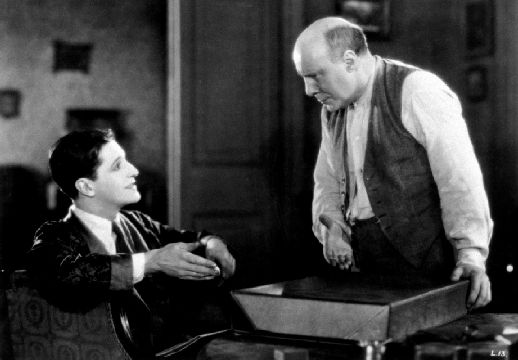The Lodger (1927) 

Director: Alfred Hitchcock
Cast: June, Ivor Novello, Marie Ault
Synopsis: A landlady suspects her new lodger is the madman killing women in London.
The Lodger marks the first of Alfred Hitchcock’s films to contain the kind of themes and striking imagery for which he is now so well known, and while the young director still clearly wasn’t yet the finished article many of his cinematic preoccupations — innocent men wrongly accused, handcuffs, blondes — are already evident. After some time working in Germany, the influence of director F. W. Murnau and expressionism are also plain to see.
The Lodger takes place in a fogbound London (its full title is The Lodger: A Story of the London Fog) gripped by fear of a serial killer known as The Avenger. Quite what this mysterious killer is avenging we never learn, but the motives for the killings are not Hitchcock’s concern here. The Avenger has a very rigid modus operandi. He only kills blondes, and only on a Tuesday night, and his calling card is his name within a triangle, and his reign of terror has people standing in the streets reading neon news strips for the latest revelations of his exploits. The movie opens with another victim fished from the Thames and then transports us to a club which boasts ‘Every Night — Golden Curls’ as if associating the routines of the dancing girls within the club with the reason for the murders. One of these dancing girls is Daisy (June Tripp, credited here only as June) who lives with her parents (Arthur Chesney and Marie Ault).
Into this family’s home one foggy night comes The Lodger (Ivor Novello), a strange young man who wears his scarf over his mouth in the fashion of The Avenger. The Lodger is, as you might expect, in search of a room to rent. Mum and Dad are initially pleased to have the room occupied by such a nice young man, but their new lodger’s temperamental behaviour eventually gives them cause for concern, particularly when Mum spies him leaving the house in the dead of night on the very night when The Avenger strikes again. Even more worrying is the interest he’s taken in their blonde-haired daughter Daisy, despite her sort-of relationship with Joe (Malcolm Keen) who, in one of those gigantic coincidences we only accept in very old movies, is the police detective upon whom investigation of the Avenger murders eventually falls.
While Hitchcock’s direction is of a much higher standard than those of most British directors of the time — with the possible exception of Anthony Asquith — The Lodger falls way short of the high standards that would later become Hitch’s trademark. Some of this is due to the production values and techniques of the day, but it’s clear that Hitchcock hasn’t yet fully attuned his instinctive sense of what makes a suspenseful movie. Although it might have fooled moviegoers back in 1927, the way he has Ivor Novello do everything he can to convince us he’s the killer is too obvious to persuade us of anything but his innocence. This might be due to the fact that Hitchcock did actually want Novello’s character to be The Avenger, so if he filmed with this ending in mind, the clues he provides us with become far too obvious!
Novello makes a rather insipid leading man, and his soft, pretty features are more appropriate for a drawing room comedy than a psychological thriller. It’s difficult to imagine him overpowering a girl, let alone murdering one. And Daisy comes across as something of an opportunist when it comes to the men in her life in the way that she brushes Joe aside with unseemly haste once the lodger, who is clearly a man of means and breeding, arrives on the scene. Poor common Joe, with his unsubtle innuendos and off-the-hanger suits doesn’t have much of a chance against such a man of culture. As Mum says — and, given Novello’s sexual orientation, surely writer Eliot Stannard had his tongue lodged firmly in his cheek when he wrote this — ‘Even if he is a bit queer, he’s a gentleman.’ It sort of makes Daisy a little difficult to care for when you think about it, which is a major drawback given that she’s the key figure in peril.
There’s plenty of notice given of the talent that was soon to mature, however, particularly in Hitchcock’s striking use of images. Most memorable amongst these is the famous scene in which Daisy and her parents stare mournfully up at the ceiling of their living room, which is directly below the lodger’s room, and we see Novello pacing back and forth through a specially constructed glass ceiling. The symbolic scene in which Novello hangs from the handcuffs which have become caught around the spike of an iron fence is also one that maintains its power. While The Lodger might prove difficult viewing to those not attuned to the rhythm and pace of silent movies, it is in fact fairly fast-moving for a movie of its era, which is an indication of Hitchcock’s near-flawless sense of timing even that early in his career.
(Reviewed 13th January 2014)
httpv://www.youtube.com/watch?v=PzlVNRzU1FE
